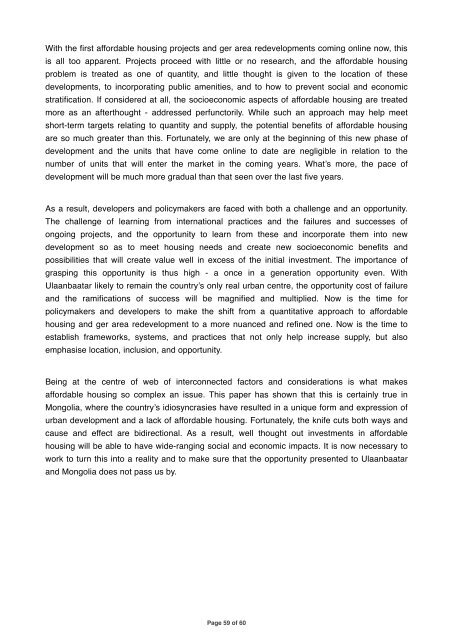REDEVELOPMENT IN ULAANBAATAR
Affordable_Housing_and_Ger_Area_Redevelopment_in_Ulaanbaatar
Affordable_Housing_and_Ger_Area_Redevelopment_in_Ulaanbaatar
Create successful ePaper yourself
Turn your PDF publications into a flip-book with our unique Google optimized e-Paper software.
With the first affordable housing projects and ger area redevelopments coming online now, this<br />
is all too apparent. Projects proceed with little or no research, and the affordable housing<br />
problem is treated as one of quantity, and little thought is given to the location of these<br />
developments, to incorporating public amenities, and to how to prevent social and economic<br />
stratification. If considered at all, the socioeconomic aspects of affordable housing are treated<br />
more as an afterthought - addressed perfunctorily. While such an approach may help meet<br />
short-term targets relating to quantity and supply, the potential benefits of affordable housing<br />
are so much greater than this. Fortunately, we are only at the beginning of this new phase of<br />
development and the units that have come online to date are negligible in relation to the<br />
number of units that will enter the market in the coming years. What’s more, the pace of<br />
development will be much more gradual than that seen over the last five years.<br />
As a result, developers and policymakers are faced with both a challenge and an opportunity.<br />
The challenge of learning from international practices and the failures and successes of<br />
ongoing projects, and the opportunity to learn from these and incorporate them into new<br />
development so as to meet housing needs and create new socioeconomic benefits and<br />
possibilities that will create value well in excess of the initial investment. The importance of<br />
grasping this opportunity is thus high - a once in a generation opportunity even. With<br />
Ulaanbaatar likely to remain the country’s only real urban centre, the opportunity cost of failure<br />
and the ramifications of success will be magnified and multiplied. Now is the time for<br />
policymakers and developers to make the shift from a quantitative approach to affordable<br />
housing and ger area redevelopment to a more nuanced and refined one. Now is the time to<br />
establish frameworks, systems, and practices that not only help increase supply, but also<br />
emphasise location, inclusion, and opportunity.<br />
Being at the centre of web of interconnected factors and considerations is what makes<br />
affordable housing so complex an issue. This paper has shown that this is certainly true in<br />
Mongolia, where the country’s idiosyncrasies have resulted in a unique form and expression of<br />
urban development and a lack of affordable housing. Fortunately, the knife cuts both ways and<br />
cause and effect are bidirectional. As a result, well thought out investments in affordable<br />
housing will be able to have wide-ranging social and economic impacts. It is now necessary to<br />
work to turn this into a reality and to make sure that the opportunity presented to Ulaanbaatar<br />
and Mongolia does not pass us by.<br />
Page 59 of 60


